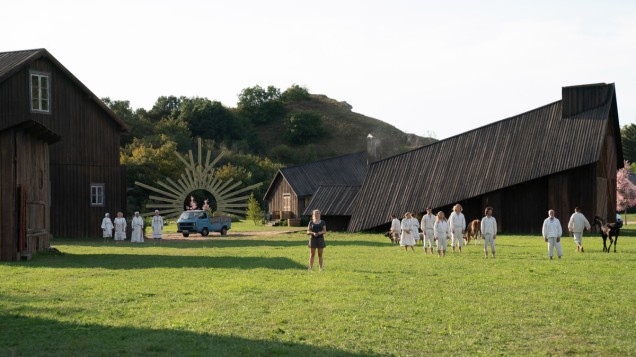
The situation for movie theaters in my hometown is dire. The inner city places are closing up one after the other because the rent is said to be too expensive for the two chains, Kitag and Quinnie. The Capitol, where I saw Return of the King, is boarded up. So is the Gotthard, where I once took a girl who was way out of my league on a date. The Jura triplex is closed, the City triplex is a provisory pub, the Royal has reopened as a vegan burger restaurant. The Splendid, the only inner city theater still showing undubbed blockbusters in 2D, is said to close soon. Instead, soulless multiplexes have sprung up at the edge of town where it is cumbersome to get to by public transport. Their viewing rooms are bigger, so the small number of viewers seems even more lost. They are run by companies that have profit as their priority, not fine movie-making programmed along a common theme or name for an appreciative or even regular audience. Granted, Pathé is a movie production and distribution company, but their multiplex is just as anonymous as that by Swisscom, the national number one telecommunications company. I only go to either of them when I have to, for instance when I want to see Jordan Peele’s Us in its original language.
Inner city theaters used to show movies in their original languages, but with subtitles. You didn’t even have to ask. The two big multiplexes show mainly dubbed versions, a big no-no for ancient movie-goers like me if the movie is in a language that I can even halfway understand. Pathé and Kitag actually advertise the fact that they are so generous to show any foreign movie in its original language once a week. One show, once a week. Used to be a time when any movie theater showed its movie undubbedthree times a day. How did that amputation ever become a selling point?

There is a silver lining, and it consists of inner city movie theaters like the Rex with its monthly themes about stars and directors. Names like Romy Schneider, Ingmar Bergman or Christian Petzold still draw crowds there, and they show art-house movie premieres and reprises that otherwise would not find their way to a big screen. And their foyer is a place to sit and drink and linger and talk and write and read and generally take a moment. – Other small mercies exist as well, like a showing of Nosferatu with live music four years ago, or the same with Battleship Potemkin later this month. It’s likely that you will see me there.
Why am I telling you all this? Because I want to explain to you why I had to travel to another city in another district in order to see Ari Aster’s Midsommar. In the German-speaking part of Switzerland, the movie will start showing as late as October 31, and undubbed, with any luck. In the French-speaking part, however, it has started in early August, mainly dubbed. That’s a three-month discrepancy I cannot explain. If I had wanted to see the movie in its original language, I would have had to travel to Geneva. Now in my younger days, I once went to Dublin to see Frances McDormand as Blanche DuBois, live on stage. It was really, really worth it. For an Ari Aster movie, Geneva is too far away.

So there I was in Fribourg, and luckily, the local multiplex is very near the train station. In the basement, there is a wall with dense handwriting on it; the young man at the ticket gate wasn’t really able to tell me what exactly we were looking at, but I could make out the names of Louis Malle and Cédric Klapisch, and a mention of Zazie dans le Métro was somewhere in there as well. I am almost sure that no Louis Malle movie has ever graced any of the ten screens of that place. The multiplex has a leafblower, probably for the popcorn, which, with any luck, makes it a leafsucker, but I digress. When I arrived, people just came out of the viewing rooms, and it was with a slight shock that I realised that I couldn’t tell how they were feeling. Were they moved by The Lion King? Did they have fun in The Secret Life of Pets 2? No clue – their faces were impassive, unreadable. Some of them just trotted to the door to the underground car park. The only kind of beauty I found was in the face of the young woman behind the concession stand: her red lipstick matched the soft brown of her freckles, and she was reading a slim volume of poetry. (I was looking for beauty in a soulless place, so forgive me for swooning over her.)
So, Midsommar. I can’t say that I know the lingo of today’s Francophonic youth, but I think what happens initially in Ari Aster’s movie is that Dani’s sister is bipolar and doesn’t pick up her cellphone and answer her mails, and Dani (Florence Pugh) is worried. She is right to worry, because I have rarely seen such a crime scene shot that seems to be clear at first, and then develops into something more twisted. From here on, I will probably bring in a few SPOILERS, for this movie and other, similar movies, so you have been warned.
There is Dani’s kind-of boyfriend Christian (Jack Reynor), who wanted to break up with her and leave for Sweden for academic research, but because Dani is traumatized, they both leave as an uneasy couple, joined by Josh, who also needs to do research, and Mark (Will Poulter), who seems to be there for vaping copiously only. There is also Pelle from Sweden, who suggests that he knows a small secluded community living a healthy, natural life and preparing for midsummer festivities, so maybe they can go there as friends and Dani can heal.

But that special place in Sweden, it turns out, offers new temptations. Drugs abound, and soon enough, our friends sit in a field, stoned, the green lush meadow is eerily waving at their feet, and they all wonder how the fork it is still that sunny at 9 o’clock at night. There is an effective chasm in Aster’s movie: are these guys high and misjudging the time of day, or do those smooth hills, those friendly people dressed in embroidered white garments, really exist within their own time and space? Because they clearly have their own rules for praying, eating, drinking and dancing. There is a young woman smiling happily at Christian, who is equally flattered and disquieted by her attention. At this point in the movie, it’s impossible not to think of The Wicker Man. On my way home, I also thought of Picknick at Hanging Rock or even some episodes of Lost.
And this, by and large, is Midsommar‘s main problem. Everything I saw and heard was something that I thought I had heard and seen already somewhere else. The sacrifice of the two eldest persons in the camp is a chill of cold water down anyone’s spine, but it reminded me of Roy Andersson’s Songs from the Second Floor (and, weirdly coincidentally, Andersson is also Swedish). The characters, most of all Christian and Josh, quarrelling about who has dibs on reporting about that weird community, are not nearly as interesting to watch as, say, Toni Colette’s character Annie from Hereditary. Christian’s and Josh’s squabbles are petty, and their requests for taking pictures of the commune’s holy writ is deeply insensitive and should have been handled better. Hereditary contained people who where as smart as me; Midsommar, with the exception of Dani, contains characters who should know better. Mark gets killed for exactly that reason.
Besides the death of Dani’s family and the sacrifice of the elders, there is a third memorable scene in the movie. Christian is finally manipulated into having intercourse with the young smiley maiden. There is a semi-circle of naked women standing around the couple, singing and vocalizing. Christian is deeply distracted by this, and I realized that in such scenes, the chanting never interrupts the intercourse – it’s as if the chanting exists within and without the scene at the same time, yet not fully in either realm. Here, the fact that Christian half-forgets that he has sexual congress is a hefty dose of realism, and it’s funny because then the chanting becomes silly, but still very distracting. While the sex is still going on.
And Midsommar ends the way that most people would guess it ends. The longer the movie goes on, the clearer the parallels to Suspiria are: the very reluctant heroine becomes their most ardent guiding light. Dani, who wanted to escape the place, ends up being the new queen of the place. She who fought the most gives in and accepts the highest rank that the place has to offer. Florence Pugh’s performance is solid, but I didn’t find her transition quite credible. There is a sequence involving primal scream therapy, but how can a person like Dani exorcise the loss of her whole family just by yelling for half an afternoon in the sun? The placements of the dead bodies refers to Annie’s dollhouses in a way, but is far less scary or disturbing than any scene from Hereditary. It feels as if Aster was content to start filming with only a half-baked draft of a screenplay in his hands. He should have rewritten some of the scenes and dumped superfluous characters like Mark for good.
One thought on “Slow Deaths in the Sun”